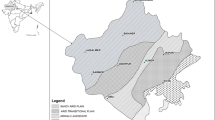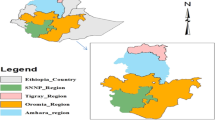Abstract
Soil loss tolerance (T) is the maximum rate of annual soil erosion that is tolerated and still allows a high level of crop productivity to be sustained economically and indefinitely. In the black soil region of Northeast China, an empirically determined, default T value of 200 (t/km2·a) is used for designing land restoration strategies for different types of soils. The objective of this study was to provide a methodology to calculate a quantitative T for different black soil species. A field investigation was conducted to determine the typical soil profiles of 21 black soil species in the study area and a quantitative methodology based on a modified soil productivity index model was established to calculate the T values. These values, which varied from 68 t/km2·a to 358 t/km2·a, yielded an average T value of 141 t/km2·a for the 21 soil species. This is 29.5% lower than the current national standard T value. Two significant factors that influenced the T value were soil thickness and vulnerability to erosion. An acceptable reduction rate of soil productivity over a planned time period of 1% is recommended as necessary for maintaining long-term sustainable soil productivity. Compared with the currently used of regional unified standard T value, the proposed method, which determines T using specific soil profile indices, has more practical implications for effective, sustainable management of soil and water conservation.
Similar content being viewed by others
References
Alexander E B, 1988a. Rates of soil formation: Implications for soil-loss tolerance. Journal of Soil Science, 145(1): 37–45.
Alexander E B, 1988b. Strategies for determining soil-loss tolerance. Environmental Management, 12(6): 791–796.
Benson V W, Rice O W, Dyke P T et al., 1989. Conservation impacts on crop productivity for the life of a soil. Journal of Soil and Water Conservation, 44(6): 600–604.
Browning G M, Parish C L, Lass J G, 1947. A method for determining the use and limitations of rotations and conservation practices in the control of erosion in Iowa. Journal of the American Society of Agronomy, 39(1): 65–73.
Cook K, 1982. Soil loss: A question of values. Journal of Soil and Water Conservation, 37(2): 89–92.
Dane J H, Topp G C, 2002. Methods of Soil Analysis: Part 4. Physical Methods. USA: Soil Science Society of America Press.
Duan X W, Xie Y, Fen Y J et al., 2009. Study on the method of soil productivity assessment in northeast black soil regions of China. Scientia Agriculturae Sinica, 42(5): 1656–1664.
Fan H M, Cai Q G, Guo C J et al., 2006. Study on criterion of soil loss tolerance and soil and water conservation in black soil region of Northeast. Journal of Soil and Water Conservation, 20(2): 31–35.
Gantzer C J, McCarty T R, 1987. Predicting corn yield on a Claypan soil using a productivity index. Trans. ASAE, 30: 1347–1352.
Gong Z T, 1999. Chinese Soil Taxonomy: Theory, Methodologies and Applications. Beijing: Science Press. (in Chinese)
Hays O E, Clark N, 1941. Cropping system that helps control erosion. USA: University of Wisconsin, Bulletin, No.452.
Hudson N, 1995. Soil Conservation. Ames, IA, USA: Iowa State University Press, 40–42.
Karlen D L, Stott D E, 1994. A framework for evaluating physical and chemical indicators of soil quality. In: Doran J W, Coleman D C, Bezdiek D F et al. (eds.). Defining Soil Quality for a Sustainable Environment. USA: Soil Science Society of America, 53–73.
Kiniry L N, Scrivner C L, Keener M E, 1983. A soil productivity index based upon predicted water depletion and root growth. Res. Bull. 1051. Univ. of Missouri. Coll. Agr., Food Agr. Exp. Sta.
Klingebiel A A, 1961. Soil factors and soil loss tolerance. In: Soil Loss Prediction, North and South Dakota, Nebraska, and Kansas. USA: Soil Conservation Service. United States Department of Agriculture.
Larson W E, Pierce F J, Dowdy R H, 1983. The threat of soil erosion to long-term crop production. Science, 219: 458–465.
Liu B Y, 2003. Approach to issues of soil deterioration and sustainable utilization of typical chernozem region. Soil and Water Conservation of China, (12): 28–29. (in Chinese)
Liu B Y, Yan B X, Shen B et al., 2008. Current status and comprehensive control strategies of soil erosion for cultivated land in the northeastern black soil area of China. Science of Soil and Water Conservation, 6(1): 1–8. (in Chinese)
Liu G S, 1996. Soil Physics and Chemistry Analysis and Description of Soil Profiles. Beijing: Standards Press of China.
Liu X T, Yan B X, 2009. Soil erosion and food security in the northeast black soil region. Soil and Water Conservation in China, (1): 17–19. (in Chinese)
Miao C Y, 2006. The soil formation age and soil loss tolerance in typical black soil of Northeast China [D]. Graduate School of Beijing Normal University. (in Chinese)
Ministry of Water Resources of the People’s Republic of China, 1997. Standards of the Classification of Soil Erosion in China. Beijing: China Water Power Press. (in Chinese)
Morgan R P C, Davidson D A, 1986. Soil Erosion and Conservation. Harlow Essex, UK: Longman Scientific & Technical, 162–164.
National Soil Survey Office (NSSO), 1995. Chinese Soil Genus Records (Vol.2). Beijing: China Agriculture Press.
National Soil Survey Office (NSSO), 1998a. Soil of China. Beijing: China Agriculture Press, 318–336. (in Chinese)
National Soil Survey Office (NSSO), 1998b. Soils of China. Beijing: China Agriculture Press, 878–879. (in Chinese)
Neill L L, 1979. An evaluation of soil productivity based on root growth and water depletion [D]. University of Missouri-Columbia.
Pierce F J, Larson W E, Dowdy R H et al., 1983. Productivity of soils: Assessing long-term changes due to erosion. Journal of Soil and Water Conservation, 38(1): 39–44.
Pierce F J, Dowdy R H, Larson W E et al., 1984a. Soil productivity in the corn belt: An assessment of erosion’s long-term effects. Journal of Soil and Water Conservation, 39(2): 131–136.
Pierce F J, Larson W E, Dowdy R H, 1984b. Soil loss tolerance: Maintenance of long-term soil productivity. Journal of Soil and Water Conservation, 39(2): 136–138.
Runge C F, Larson W E, Roloff G, 1986. Using productivity measures to target conservation programs: A comparative analysis. Journal of Soil and Water Conservation, 41(1): 45–49.
Shen B, Fan J R, Pan Q B et al., 2003. The overview of the soil loss prevention and control pilot project in Northeast black soil region. Soil and Water Conservation in China, 11: 7–8. (in Chinese)
Shi X Z, Yu D S, Warner E D et al., 2006. Cross-reference system for translating between genetic soil classification of China and soil taxonomy. Soil Science Society of America Journal, 70: 78–83.
Skidmore E L, 1982. Soil loss tolerance. In: Determinants of Soil Loss Tolerance. American Society of Agronomy, ASA Special Publication No.45: 87–94.
Smith D D, 1941. Interpretation of soil conservation data for field use. Agriculture Engineering, 22: 173–175.
Stamey W L, Smith R M, 1964. A conservation definition of erosion tolerance. Soil Science, 97(3): 183–186.
Tang K L, Zhou P H, 1988. The discussion of soil erosion issues Loess Plateau. Memoir of NISWC, Academe in Sinica and Ministry of Water Conservancy, (7): 1–4. (in Chinese)
Wang G L, Zhang G Z, 1983. Soil knowledge and general detailed of soil survey technology. Beijing: Water and Electric Power Press. (in Chinese)
Wang J G, Yang L Z, Shan Y H, 2001. Application of fuzzy mathematics to soil quality evaluation. Acta Pedologica Sinica, 38(2): 176–183.
Wischmeier W H, Smith D D, 1965. Predicting Rainfall Erosion Losses from Cropland East of the Rocky Mountains. USA: United States Department of Agriculture, Agriculture Handbook. No.282, Washington, D.C.
Wischmeier W H, Smith D D, 1978. Predicting rainfall erosion losses: A guide to conservation planning. USA: United States Department of Agriculture, Agriculture Handbook. No.537, Washington, D.C.
Yan B X, Tang J, 2005. Study on black soil erosion rate and the transformation of soil quality influenced by erosion. Geographical Research, 24(4): 499–506. (in Chinese)
Yang C Q, Cai Q G, Fan H M, 2004. Process of soil loss tolerance research in the phaeozem region of Northeast China. Research of Soil and Water Conservation, 11(4): 66–96. (in Chinese)
Yu D, Shen B, Xie J, 1992. Damages caused by soil and water erosion and their controlling approaches in Northeast China. Bulletin of Soil and Water Conservation, 12(2): 25–34. (in Chinese)
Author information
Authors and Affiliations
Corresponding author
Additional information
Foundation: National Natural Science Foundation of China, No.40671111; No.41101267; Nonprofit Sector Special Funds of the Ministry of Water Resources of China, No.2010332030
Author: Duan Xingwu, Ph.D and Assistant Researcher, specialized in soil erosion and soil productivity assessment.
Rights and permissions
About this article
Cite this article
Duan, X., Xie, Y., Liu, B. et al. Soil loss tolerance in the black soil region of Northeast China. J. Geogr. Sci. 22, 737–751 (2012). https://doi.org/10.1007/s11442-012-0959-5
Received:
Accepted:
Published:
Issue Date:
DOI: https://doi.org/10.1007/s11442-012-0959-5




